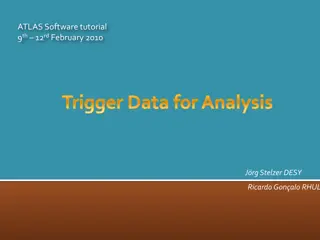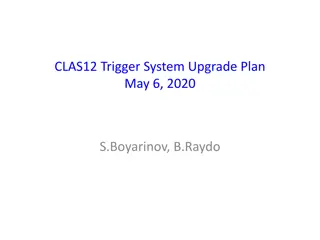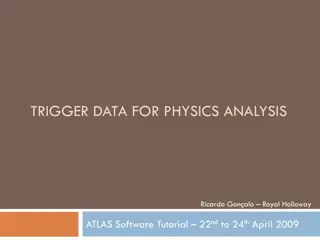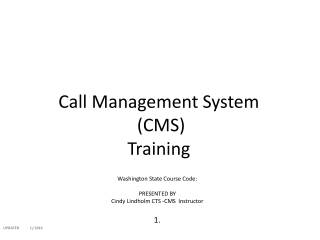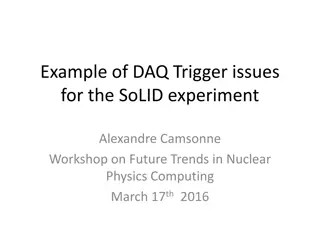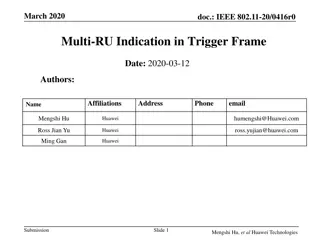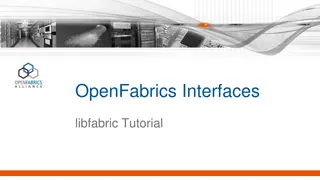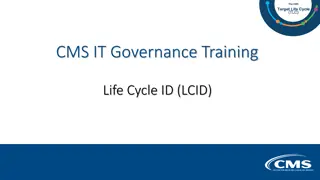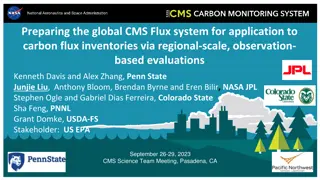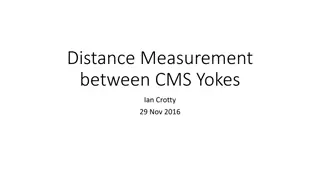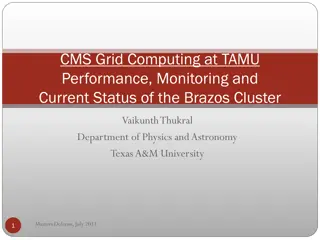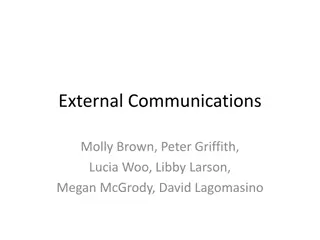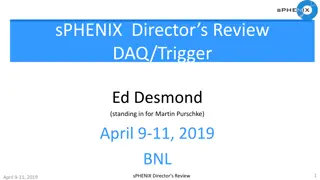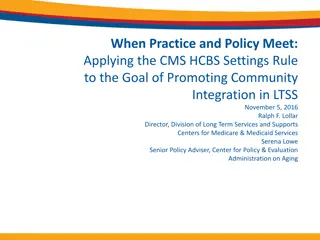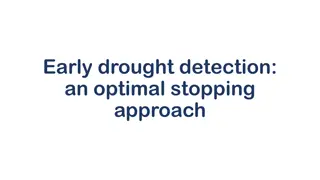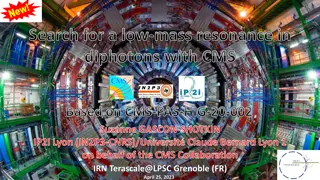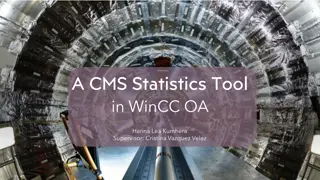Understanding CMS High Level Trigger Tutorial
Dive into the world of CMS High-Level Trigger system with this tutorial covering topics such as trigger constraints, HLT menu/path, hardware and software components, decision processes, and event recording. Explore the functionality of Level 1 triggering, High-Level Trigger streams, and the intricate process of event selection and reconstruction. Get insights into the importance of accurate decision-making within tight timeframes in particle physics research.
Download Presentation

Please find below an Image/Link to download the presentation.
The content on the website is provided AS IS for your information and personal use only. It may not be sold, licensed, or shared on other websites without obtaining consent from the author. Download presentation by click this link. If you encounter any issues during the download, it is possible that the publisher has removed the file from their server.
E N D
Presentation Transcript
Introduction to HLT-Top Tutorial Stephanie Beauceron IPNL Javier Fernandez - Oviedo If after Tutorial you have questions, please do not hesitate to send them on: hn-cms-top-trigger (alias for CMS Top Trigger Studies) (low rate of emails) 1
Outline What is trigger system in CMS? What are the HLT constraints? Tutorial Phase: - What is an HLT menu/path? - How to run an HLT menu? - Which menu should I run? What should be done for a path integration? 2
Trigger System L1: hardware, firmware Quick readout of specific detectors (no tracker, no [yet] Muon iso) L1 Latency: 3.2 s HLT: High Level Trigger: software based (~10k CPUs) look at full event content of L1 selected events Mean time per event HLT: 150 ms (depending on CPU) Consecutive decision, what ever is not passing L1, will not be seen by HLT 3
Level 1 L1: Mix of FPGAs and ASICs Many copper parallel links Internal bandwidth constraints e.g. jet finding Detectors designed to accommodate: 100 kHz maximum L1 rate max latency 4 s Very first decision step, need to have it correct! L1 group is looking for (wo)manpower ( So far studies based on 2012 L1 Menu ESP reward) 4
High Level Trigger Streams 500Hz LumiPixel LHC Alignment, Calibration and Luminosity (Event Size ~kB) 10 kHz Pi0/Eta 1.5 kHz EcalPhiSym 1.5 kHz RPCMonitoring 100 Hz Calibration ~15 MHz Level 1 FPGA and custom ASIC technology Physics 1 kHz Stream A (Full Event Content), Scouting (Event Size ~kB) 40 Hz Express 1.2kHz Data Scouting 25 Hz Stream B (Monitoring Parking) Trigger Studies (L1) (Event Size ~kB) 10 kHz NanoDST 75 Hz DQM ~100k Hz Data Quality and Monitoring (Various Event Content) High Level Trigger 1 kHz HLTDQMResults 150 Hz HLTDQM 20 Hz HLTMonitoring software on a filter farm of commercial rack- mounted computers, comprising over 13000 CPU 5
HLT Decision of recording or not an event based on full event information. What is seen by HLT is RAW format of event: Various electronic signal coming from each subdetector In order to decide if the event is interesting or not, need to interpret electronic signal into particles Unpacking Reconstruction of the event Selection of the event based on reconstruction infos Same principle than offline physics analysis based on the same objects! Nuance: Offline reconstruction can take as much time as needed (currently ~35s), Online reco + Decision (ie: HLT) should be over within 150ms (mean value)! Not possible to do exactly the same, a few approximations are performed to speed up! 6
HLT Constraints - Input rate is limited to 100 kHz at L1 (not by L1 trigger), by the limitation of the readout of the detectors (including the S-links limitation which connect the detectors with the event building) - The maximum output rate of HLT, which may matter for some test run, is limited by the write speed, and the limit is few kHz at the nominal event size (and depends both on the event size and rate) - The limit during nominal data taking comes from the downstream computing resources, and it is much smaller than the technical limit. So this limit is not a peak limit (events/s) but an average limit (events/day) which gets translated in events/s for convenience. Typically ~500Hz as reco time is ~35 s per events. If event is not recorded, offline it is impossible to know the event is not there Crucial to make good decision! 7
Summary of HLT constraints HLT should reject most of the events to select only ~1kHz 1kHz should be split within PAGs Developing a path = rate calculation (Zeynep s talk) HLT is taking crucial decision! New physics can be missed because no decision algorithm was designed to keep such events (by default HLT reject events) Developing a path = validation/efficiency (Kelly/Hugues talk) HLT should do as well as offline reconstruction with a factor 100 less time! Developing a path = time calculation (Javier s talk) Impossible to correct HLT at posteriori! If JES at HLT or alignment is not correct, events are gone Developing a path = DQM (Federico s talk) 8
HLT RECO Most of the difference between HLT and Reco are in tracking (where most of the time is spent) Order of the module/sequence crucial: first run what is discriminant and not time consuming. Crucial work from HLT POGs to ensure that all final objects are as close as possible to reco ones. PAGs work start from HLT object definition blessed by POG. Aim is NOT to build the exact same analysis at HLT (normally looser cuts), only to make sure to record most interesting events! Example: Looking for ttbar events, pointless to record ALL events containing W s. Events as W+3/4jets are enough. 9
Selection at HLT Looking for ttbar events, pointless to record ALL events containing W s. Events as W+3/4jets are enough. Selection should be loose enough to record all signal events and all events needed for background estimation (or prescale path) BUT tight enough to reduce the rate: All inclusive W l (lepton is isolated) cannot be recorded as the rate would be ~200Hz [at 13 TeV] (1/5 of the full CMS bandwidth VBF physics as all hadronics final states or searches with MET or non-isolated lepton would not be happy ). In the meantime strategy to estimate background should change (inverting isolation will be difficult) Need to share and to tighten a bit Need to define a STRATEGY (within one PAG and over) 10
Overview of L1 EG issues A CMS collaborator concerned about Standard Model Physics at 13TeV in electron channel 11
Physics Issues at 13 TeV PU40 25ns PU40, 25ns, 1.4E34 8 TeV data 50 ns, PU~25, lumi~5.3E33 No-eta restriction 8 TeV are eta restricted too Factor ~7 Factor ~9 Factor ~9 Factor ~7 Isolation is using very loose isolation (<0.5) but with better calculation than in 2012. Physics at ~20 GeV should be mainly driven by W by ~2 (x2.6 for lumi). What is important is the total Eg rate (not purely Iso). SingleEG included already IsoEG rate Increase of rate inconsistent with pure increase of physics process Study of purity lnu, cross section is increasing only 12
Purity of L1EG Idea: Run on samples with no/low expected electron rate Use mu + jets skim from Ttbar 3224 events are selected. Technicalities: First find isolated candidate, then look for non-isolated. When candidate reach >63GeV [RCT saturation], by default non isolated Legacy Non Iso: L1_SingleEG5 3059 L1_SingleEG20 1798 L1_SingleEG24 1648 L1_SingleEG30 1500 L1_SingleEG60 964 Legacy Trigger: L1_SingleIsoEG5 L1_SingleIsoEG20 288 L1_SingleIsoEG24 216 L1_SingleIsoEG30 148 L1_SingleIsoEG60 31 1907 Tightening isolation to clean fakes UCT Iso 0.5: L1_SingleIsoEG5 L1_SingleIsoEG20 1325 L1_SingleIsoEG24 1253 L1_SingleIsoEG30 1179 L1_SingleIsoEG60 943 UCT Iso 0.2: L1_SingleIsoEG5 L1_SingleIsoEG20 1146 L1_SingleIsoEG24 1094 L1_SingleIsoEG30 1050 L1_SingleIsoEG60 938 2631 Technicalities: First find isolated candidate, then look for non-isolated. When candidate reach >63GeV [RCT saturation], by default isolated 2711 In Legacy trigger 50% of events fired at least EG 30 GeV Same issue with UCT, tightening up isolation does not help Problem coming from RCT saturation to compute a correct isolation 13
Description Of L1 Trigger Calo Will described: 1) ID of L1 object 2) Scale 3) Calibration 14
L1 Object ID Variables only 2 handles for EG objects Ecal: FG (From A. Zabi): -Fine Gain Bit only computed in Barrel and used at RCT if ET > 6 GeV -Nothing in Endcap as not needed for Run1, can be deployed for Run2 RCT: HoE (private chat with M. Cepeda): -Hcal energy is 0- suppressed -HoE cut as followed: If ET < 30 GeV && HoE>0.05 Reject Personal remarks: 30 GeV cut off was selected to avoid loosing efficiency for high et electron/photons 0.05 is also a very tight value, no? Anything depositing more than 30 GeV in Ecal Endcap 15 Is a L1EG candidate!
L1 Calo Scales EcalTPG (From A. Zabi): linear 8 bits from 0 to 128 GeV, LSB = 0.5 GeV HcalTPG (From F. Lacroix + RCT LUTs): non-linear 8 bits from 0 to ~180 GeV RCT (from RCT code): Convert Ecal 8 bits to Ecal 7 bits via: unsigned long maxValue = (1 << precision) - 1; if(etBits > maxValue) return maxValue; So they keep the same LSB (0.5) but sur 7 bits as input. RCT output: 6 bits for Et of EG candidates RCT Out: LutOut(0:17)= LinearEMET(0:6)+HoEFGVetoBit(7:7)+LinearJetET(8:16)+ActivityBit(17:17) 16
Example of Studies on HoE Using UCT tools and change in Lut.py: Start with remove Zeroing Of Hcal (thanks to RCT experts to warn that it was a mistake So rerun without this mistake, perhaps not the only one ), run on Mu+jets skim (3224 events) [Concentrate on Isolation bits] Move from 30 GeV boundary to 64 GeV (keep 0.05 cut) Iso 0.5 L1_SingleIsoEG5 L1_SingleIsoEG20 L1_SingleIsoEG24 L1_SingleIsoEG30 L1_SingleIsoEG60 0.05 cut probably too tight for 64 GeV electron Have to be careful should run on signal too! Rates still dominated by saturated object % of Evts 80.2 29.4 27.2 25.3 20.1 Iso 0.5 L1_SingleIsoEG5 L1_SingleIsoEG20 41.0 L1_SingleIsoEG24 38.9 L1_SingleIsoEG30 36.6 L1_SingleIsoEG60 29.2 % of Evts 84.0 Move from 30 GeV boundary to 200 GeV (keep 0.05 cut) Iso 0.5 L1_SingleIsoEG5 L1_SingleIsoEG20 19.1 L1_SingleIsoEG24 16.8 L1_SingleIsoEG30 14.6 L1_SingleIsoEG60 8.1 0.05 cut probably too tight up to 200 GeV electron Have to be careful should run on signal too! BUT rates NO More dominated by saturated object. HoE before saturation % of Evts 77.9 17
Example of Studies on HoE Move from 30 GeV boundary to 200 GeV (keep 0.05 cut) Iso 0.5 L1_SingleIsoEG5 L1_SingleIsoEG20 19.1 L1_SingleIsoEG24 16.8 L1_SingleIsoEG30 14.6 L1_SingleIsoEG60 8.1 Iso 0.5 L1_SingleIsoEG5 L1_SingleIsoEG20 41.0 L1_SingleIsoEG24 38.9 L1_SingleIsoEG30 36.6 L1_SingleIsoEG60 29.2 % of Evts 84.0 % of Evts 77.9 Move from 30 GeV boundary to 200 GeV move cut to 0.5 (HoE<0.5) Iso 0.5 L1_SingleIsoEG5 L1_SingleIsoEG20 41.5 L1_SingleIsoEG24 37.8 L1_SingleIsoEG30 33.6 L1_SingleIsoEG60 22.9 Move from 30 GeV boundary to 200 GeV move cut to 1 (HoE<1) Iso 0.5 L1_SingleIsoEG5 L1_SingleIsoEG20 45.4 L1_SingleIsoEG24 41.7 L1_SingleIsoEG30 37.7 L1_SingleIsoEG60 27.4 % of Evts 89.6 % of Evts 91.1 1 cut extremely loose and it is marginally reducing saturated object and it is inefficient for low ET stuff. 0.5 should still be OK for physics up to 200 GeV but rate reduction is still marginal 0.5 starts to loose power around 20 GeV in ET 18
Example of Studies on HoE Move from 30 GeV boundary to 200 GeV move cut to 0.5 (HoE<0.5) Iso 0.5 L1_SingleIsoEG5 L1_SingleIsoEG20 41.5 L1_SingleIsoEG24 37.8 L1_SingleIsoEG30 33.6 L1_SingleIsoEG60 22.9 % of Evts 89.6 Iso 0.5 L1_SingleIsoEG5 L1_SingleIsoEG20 41.0 L1_SingleIsoEG24 38.9 L1_SingleIsoEG30 36.6 L1_SingleIsoEG60 29.2 % of Evts 84.0 Move from 30 GeV boundary to 200 GeV move cut to 0.3 (HoE<0.3) Iso 0.2 L1_SingleIsoEG5 L1_SingleIsoEG20 30.8 L1_SingleIsoEG24 27.7 L1_SingleIsoEG30 25.0 L1_SingleIsoEG60 18.8 Move from 30 GeV boundary to 200 GeV move cut to 0.5 (HoE<0.5) Iso 0.2 L1_SingleIsoEG5 L1_SingleIsoEG20 34.7 L1_SingleIsoEG24 31.6 L1_SingleIsoEG30 28.7 L1_SingleIsoEG60 22.7 % of Evts 85.5 % of Evts 87.6 Combined with isolation tightening allow to control the rate increase at low Et 0.3 should still be OK for physics up to 200 GeV (at HLT, 0.3 cut for >~98% on signal) but Iso 0.2 can be a bit too tight. Nevertheless this combination reduce the fake by ~40% at 30 GeV Far to be final word! Just a naive and quick study Personal Conclusion: RCT people should do HoE tuning but not sure if tuning of the variable can be done alone, probably have to do it combining with Isolation tuning 19
Summary Presenting list of current issues with EG L1 bits Identify handle: scale (Ecal/RCT), Id: Fine grain bit in Ecal endcap, HoE, isolation At the end mainly HoE is doing a bit but a tiny bit only Major issue remains 20
Single Lepton Paths Identification Moving the rate calculation using MC: Large rate increase Try to retune criteria to reduce further the rate (first iteration, further iteration will be requested) WP75:Efficiency on ttbar: 61.6% [WP85: 65.5%] for pt>27GeV Barrel signal efficiency : 74.4% and background rejection : 98.9% Endcap: signal efficiency : 72.2% and background rejection : 96.5% Rates calculation (numbers in back up) for 1.4E34 [Michal recipe]: Ele27_WP75 (L1IsoEG25er): 189 7.6 Hz Ele30_WP75 (L1IsoEG28er): 157.8 6.4 Hz Ele32_WP75 (L1IsoEG30er): 134.7 5.5 Hz Turn on curve of Ele27_WP75: wrt to Gen level with pt>25 GeV and | |<2.5 If we consider 2GeV steps, and cut at reco at ~ 29 GeV, we will be above 50% in the turn on curve. Plateau not reached before ~45 GeV (too High for top) Top will work in the electron turn on curve Afiq Anuar 21


